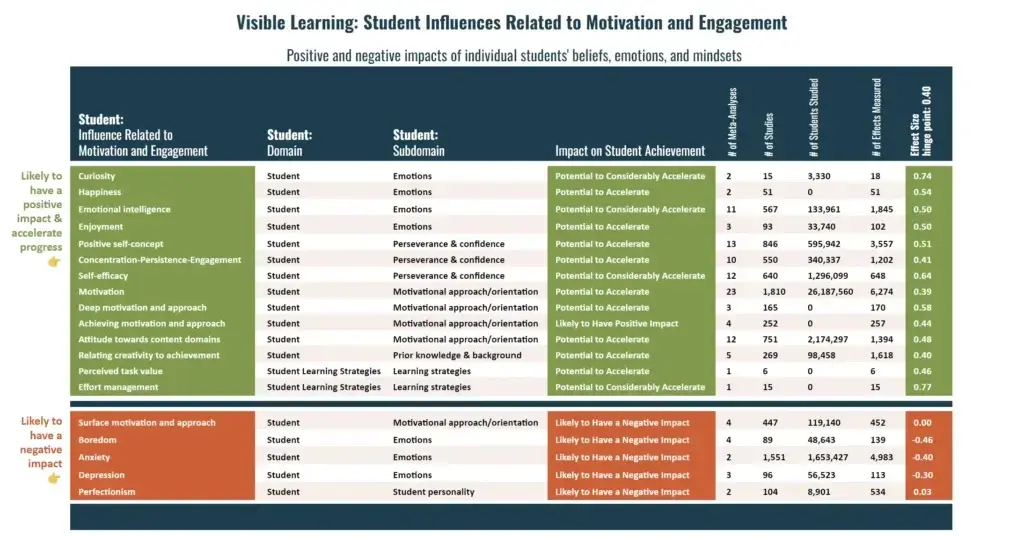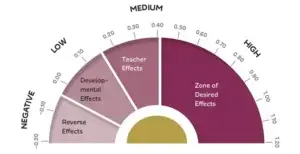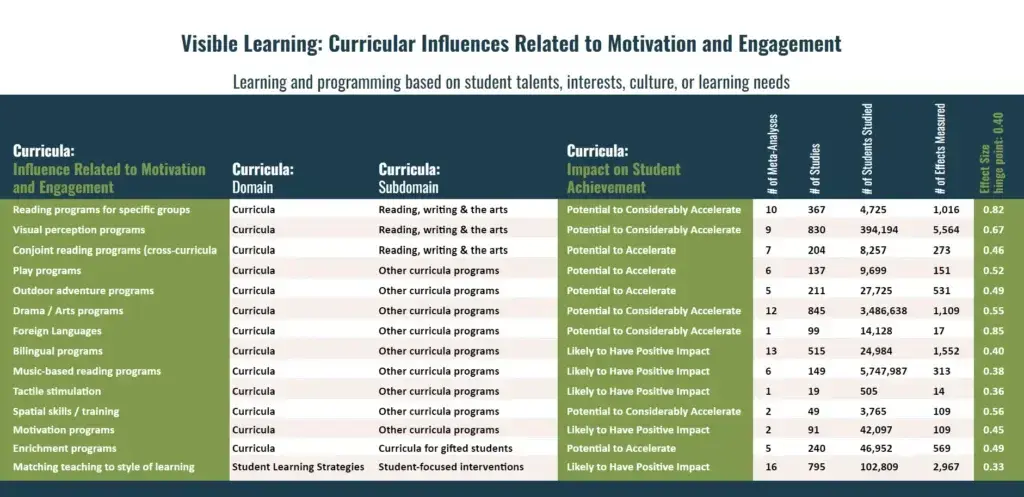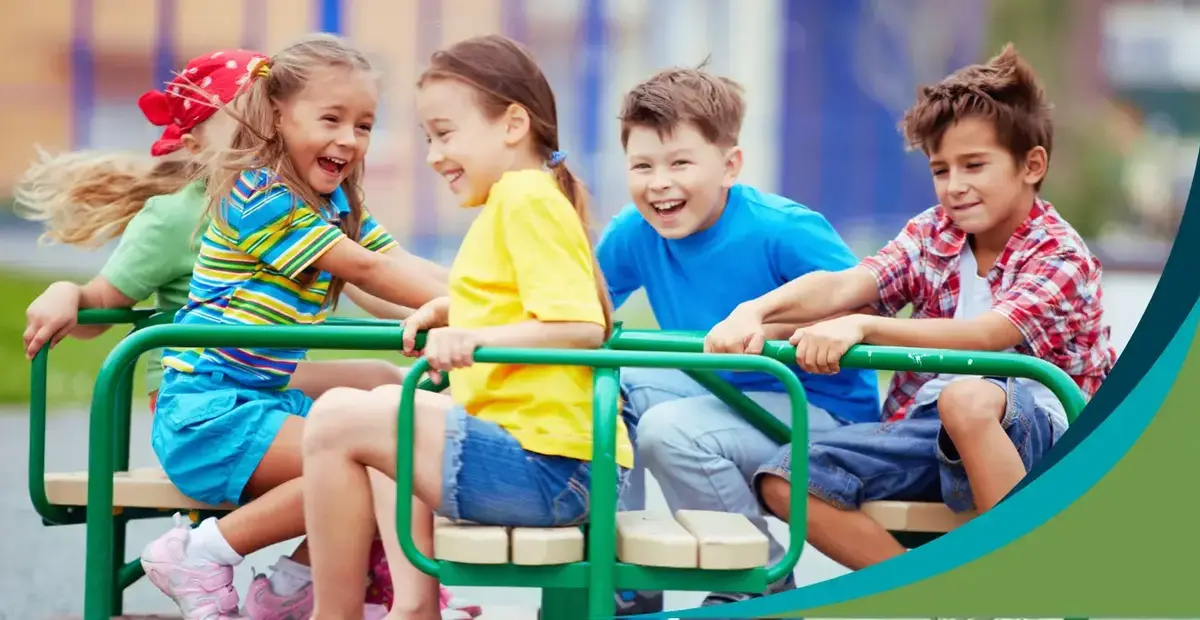Without student motivation and engagement, everything fails
Before we reveal the special significance of student motivation and engagement, let’s look back and connect with the influences we previously explored. While it’s not essential to read all the articles before this one, you may find it gives both a more comprehensive picture and a more detailed analysis.
Our first article provides background on the Visible Learning research and use of effect size. Part 2 focuses on comprehension influences, while Part 3 goes into fluency influences. Then, Part 4 highlights the high-effect size influences related to independent reading. The most recent article, Part 5, discusses leveraging caregiver support to help improve achievement.
In our series, we’ve covered some big, beefy categories of educational practices, all with the ultimate goal of accelerating reading progress to boost proficiency before spring assessments.
Whatever you need, there is one factor without which all your efforts will fail... Motivation.
No matter your location, population, or reading proficiency percentage, student motivation and engagement can help move the needle.
The psychology of student motivation and engagement
As a literacy leader, you're on the cutting edge of education research and theory. Yet, the psychology of motivation and engagement goes back decades. You definitely discussed it in Ed Psych during your undergrad.
So why are we still talking about it? We’ll get there.
But first, here's your 30-second refresher course...
Today's classrooms are underpinned by the constructivist theory of learning “that emphasizes the active role of learners in building their own understanding.” This active role “promotes a sense of personal agency as students have ownership of their learning and assessment.”
In other words, learning only happens successfully when a student actively participates in the process. Of course, we can't force kids to participate; they must make the choice on their own.
What can we do? Make the option to learn engaging enough that students are so motivated they can't help but join in.
Easy, right? (Just joking… sort of…)
We're only partially joking, because motivating kids to read more books outside of school time is exactly what we set out to accomplish over a decade ago. We’re thrilled to report we’ve been hugely successful! In fact, the schools who partner with us have reported that even their reluctant readers showed improvement in their reading progress with our program!
97% of students improved or maintained their reading level with Kids Read Now!
At Gregg School, where we have participated for three years, we were pleasantly surprised to discover that 71% of our students grew one or more reading levels from June to September, and 26% remained the same. This is an incredible accomplishment...
"...and we attribute the fact that 97% of our returning 3rd-5th grade readers maintained or grew their skills over the summer break to their participation in the Kids Read Now program!!"
Student motivation by the numbers
It’s true that every single student can and must be motivated to learn. It’s also true that every student is distinctly individual.
Multiply that individuality by the number of students in your classroom, your school, and your district.
It can understandingly feel overwhelming trying to account for complex variations in backgrounds, cultures, languages, access to resources, interests, abilities, likes and dislikes, strengths and weaknesses, and infinitely more factors.
No wonder many of us aren’t sure where to start!
Thankfully, Dr. John Hattie’s Visible Learning meta-analyses provide some guidance about variables that influence student motivation and engagement.
What can you do? Analyze the effect size and the potential to accelerate student achievement outlined in the table below 👇and review each through the lens of your own student body. Only then can you begin on an evidence-based path.
The Student: Zooming in on influences related to students' beliefs, emotions, and mindset
Remember when you bookmarked the Global Research Database so you could continually use it to investigate individual influences from the Visible Learning research? No? That’s OK — you can save it now: www.visiblelearningmetax.com/Influences.
When it comes to motivation and engagement, we’ve done the leg work for you! And during our analysis, we noticed something significant…
A great number of the influences related to motivation and engagement fall under the domain “Student." These variables have to do with students as individual humans. A student's personal beliefs, emotions, and mindsets appear to have both positive and negative impacts on achievement.
In the table below, we compiled a list of influences studied in Dr. John Hattie’s meta-analyses that met these criteria:
- Influence: related to motivation and/or engagement
- Domain: Student or Student Learning Strategies
- Top (green): Effect size near or above the hinge point (average) of 0.40; in the Zone of Desired Effects
- Bottom (red): Effect size near or below 0 (small, neutral, or negative)

Effect Size Barometer
To learn more about the Visible Learning data — its sources, interpretation, and implications for your educational practice — visit the first article in this blog series: High Effect Sizes Accelerate Reading.

Because you and your staff are limited by the all-important but finite resource — time — it means you, your instructional designers, and literacy leaders must be picky about what you focus upon.
You’re not searching for just any solution; you need to know specifically what can accelerate student achievement to increase the chances of students meeting spring and end-of-year benchmarks.
The Visible Learning research can help with that! When implemented effectively, these motivation and engagement influences have the potential to accelerate or considerably accelerate student achievement. Bingo!
Are your K-5 classrooms in need of fun activities to motivate students to read? Get the free teacher and family pack below!
Inside each pack are 9 creative ways to help boost students' desire to read more in the classroom and at home. While these don't deliver outcomes equivalent to participating in the Kids Read Now program, they do offer activities and game templates created by literacy experts that are sure to tempt students of all reading levels to pick up a book and engage in reading!
Visible Learning's number one factor influencing student achievement
You just perused the table of motivation and engagement influences related closely to students themselves. Factors like a student’s curiosity, emotional intelligence, positive self-concept, self-efficacy, concentration, attitude, creativity…
You might be wondering, “Do I actually have any control over these variables?” or “What can I really do about student personalities or attitudes?”
The answer to those questions also comes from the Visible Learning research-base.
You've heard all about John Hattie's landmark meta-analyses and the most up-to-date version of his findings, Visible Learning: The Sequel (2023). But do you know what the research identified as "the number one factor influencing student achievement?"
Drum roll, please...
“Engaging teaching.”
In Visible Learning, “engaging teaching” means teaching in a way that is engaging to learners. Here are Dr. John Hattie's own words, reflecting on the outcomes of his research and the greater goal of education:
"The most important thing a teacher can do..."
According to Dr. John Hattie, schools must look beyond “hints and tips that will give schools easy hacks to good grades” and instead look at “changing the culture of education so that teachers are excited about teaching, and students are excited and engaged in learning."
"Every child can learn, can grow, and can be taught to love learning. The most important thing a teacher can do is to have high expectations for all students and to see differences as opportunities to learn in different ways, and to teach students to welcome the challenge to aim high."
- Professor John Hattie, University of Melbourne

We must find the “hook” for each student — that is, the special thing or things that personally motivate them.
Our students and families are full of information, and many are happy and willing to communicate. It’s our job to ask the right questions.
What will truly get them to pick up a book of their own volition before bed? Which types of literature is engaging enough that you can be sure they’re actually reading the words on the page? What do they value intrinsically that we can relate to literacy? What don’t they value that will turn them off from participating?
"Watching my son pick up the mail, find a book sent to him, and ripping the book out of the packaging to get right to reading and exploring the book was very refreshing and a dream come true! KRN has helped my son move from being a nonreader to one that will read at night — which he will never get in trouble for!"
- Karen, 3rd Grade Parent, Tawas Area Schools, Michigan
Building relationships is paramount to understanding the young people you serve. However, ensuring adults and students are on the same page is easier said than done…
Perception vs. reality — Roadblocks to motivation and engagement in schools
According to a recent EdWeek Research Center survey, educators and students aren’t always on the same page when it comes to motivation and engagement.
In 2023, a whopping 86% of students reported that they felt motivated to do their best in school. When teachers, principals, and district leaders were asked about their students’ motivation, only 67% felt students were motivated to do their best. That’s a 19% disparity in perception between students and adults in schools.
A similar disconnect persisted when the same population was asked about what methods specifically motivated them most. Of the top five responses for educators and students, respectively, only two overlap — offering hands-on experiences and incorporating fun or humor into class.
Even when educators and students identified the same method as motivating, they did so quite disparate degrees. For example, almost twice as many teachers, principals, and district leaders thought that students were most motivated by seeing how learning relates to their future careers.
The takeaway? Educators could be spending precious time, energy, and money implementing methods they think will motivate students to engage in learning, but students aren’t responding accordingly.
In creating student-centered classrooms, educators must embrace a growth mindset and truly seek to understand the students sitting in their classrooms. Thankfully, we’ve got proven, evidence-based solutions to guide us…
Is student distraction on the rise?
We’ve got 10 academic activities that will bring their attention back into the classroom: 👇
Get distracted students refocused and learning
Reignite learning. Sign up to get 10 quickfire academic activities that combine learning with fun. Quick and easy to weave into any lesson.
How Kids Read Now helps schools accelerate their students’ reading progress
Kids Read Now gets students to read books outside of school — period. More time reading means more practice reading which means reading progress is accelerated!
But, how do we manage this?
Kids Read Now captivates young minds by tapping into their inherent curiosity and interests, transforming these into a compelling desire for more — more tales of dragons, sports, or about kids like themselves.
This personalized approach is the cornerstone of a methodology that has proven successful where others have faltered.
By empowering students to choose their own books from a diverse and appealing selection, we not only honor their preferences but also instill a sense of ownership and anticipation. It's student choice and voice done right.
Each book, carefully selected with the guidance of a trusted adult, becomes a cherished possession. Kids Read Now mails these books directly to the child's home, signaling it's theirs to keep forever and creating a sense of belonging. With books mailed about every 10 days, the anticipation for the next delivery is a potent motivator that gets kids reading with enthusiasm.
Break barriers in your literacy progress
Discover the program that transforms reading habits and elevates district-wide literacy outcomes.
Challenge what's possible. Explore with us.
The program's thoughtful design ensures that each step — from selection to delivery — fosters a lasting love for reading, establishing a foundation for lifelong learning and exploration.
Parents and caregivers need motivation and engagement, too
But we don’t stop there.
Crucially, Kids Read Now bridges the gap between home and school by actively involving parents in their child's reading process. Each book comes equipped with specific "Discovery Questions" — a powerful tool designed to spark meaningful discussions about the book's content, themes, and characters. Conversations about literacy with trusted family members engage children and leave them motivated to
These guided conversations not only deepen comprehension, but also create enjoyable moments of connection between parents and children, reinforcing reading as a valued family activity.
Through this collaborative approach, Kids Read Now bolsters students' reading motivation while also building a supportive community around them, ensuring that the love for reading thrives in every home.
Improving spring assessment data by accelerating kids' reading now
Literacy Leaders — you made it! You made it to the sixth and final article in our Accelerating Reading blog series, and more importantly, you made it to spring assessment season.
Through the lens of Dr. John Hattie’s Visible Learning meta-analyses, you’ve gone in-depth with influences that impact student achievement. You know how to interpret effect size data, filter the vast database to meet your needs, and go deeper on exactly what’s important to you.
We grouped influences from Hattie’s 2023 meta-analyses into five categories in hopes that you’ll find what you need, depending on your literacy data:
- Do your students need to focus explicitly on comprehension? Zoom in on the Language Comprehension side of Scarborough's Rope to narrow your focus.
- Would more fluent reading increase your spring benchmark scores? Review variables targeted at specific aspects of fluency.
- Is it a matter of having enough time for independent practice? That is, do your students need more exposure to text, more stamina, or better transfer across settings? Verify the strategies that form healthy habits — and avoid the ones that don't.
- Is it time to tap into relationships with parents and caregivers? Could their strategic support help bolster progress toward your school’s end-of-year goals? Return to the article on caregiver support for reminders of the most impactful practices.
- Student-centered isn't just a method, it's a mindset. Do your educators need help discovering what makes their students “tick” to better engage and motivate them?
Next step: the end of the school year.
You got this!
Armed with your background knowledge and precision decision-making skills, hopefully this spring brings more hope and satisfaction than it might have in past years.
You now have a place to start, to revisit, and to recommend when facing critical questions in your district. May the end of your school year find you feeling prepared and proud of the work you’ve done to accelerate student learning.
Kids Read Now is honored to play a role in your journey to support student choice, voice, and lifelong learning.
Frequently Asked Questions
Question: What is the significance of student motivation and engagement in reading progress?
Answer: Student motivation and engagement are crucial factors without which all efforts to improve reading progress may fail. They play a pivotal role in driving students to actively participate in the learning process, ultimately leading to accelerated reading proficiency.
Question: How can educators effectively understand and address student motivation and engagement?
Answer: Educators can utilize evidence-based practices outlined in research, such as John Hattie's Visible Learning meta-analyses, to analyze the effect size of various factors influencing student motivation and engagement. By understanding these influences, educators can tailor their approaches to meet the diverse needs of their students.
Question: How can educators use “engaging teaching” to boost student motivation and engagement?
Answer: Engaging teaching involves creating learning environments that excite and involve students in the learning process. The learning is so compelling that students can’t help but want to join in. Educators can achieve this by fostering high expectations for all students, leveraging praise as motivation, and embracing differences as opportunities for learning.
<strong>Question: What are some common roadblocks schools face in promoting student motivation and engagement?</strong>
Answer: Common roadblocks include disparities in perception between educators and students regarding motivation, as well as challenges in implementing methods that effectively motivate students. It's essential for educators to bridge these gaps by maintaining growth mindsets and creating truly student-centered classrooms.
<strong>Question: How can educators overcome challenges related to student motivation and engagement?</strong>
Answer: Educators can overcome challenges by building strong relationships with students, actively seeking to understand their interests and motivations, and implementing evidence-based strategies that align with students' needs and preferences.



